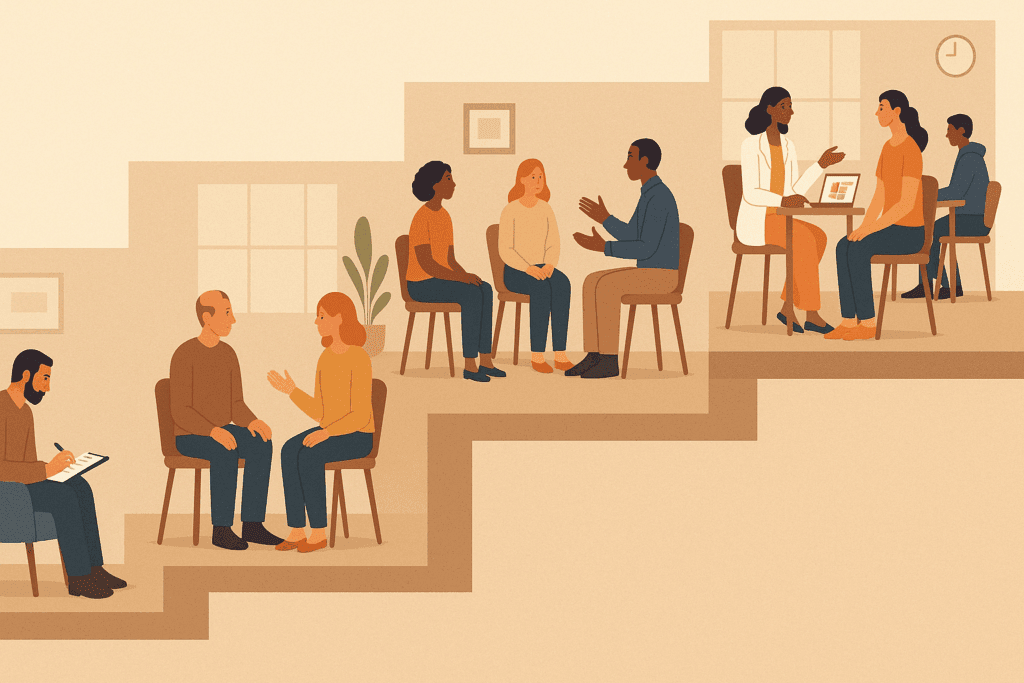The Rising Need for Comprehensive Outpatient Eating Disorder Treatment for Adults
In recent years, the demand for accessible, comprehensive mental health care has sharply increased, particularly among adults navigating complex psychological and nutritional challenges. Among the most misunderstood yet pervasive conditions are eating disorders, which affect people across a broad spectrum of ages, genders, and socioeconomic backgrounds. As awareness grows and the stigma surrounding mental health diminishes, more adults are seeking treatment that supports both psychological and physical healing. One increasingly vital option is outpatient eating disorder treatment for adults, a model that offers flexibility, evidence-based care, and continuity with everyday life.
You may also like: How to Stop Emotional Eating and Regain Control: Mindful Nutrition Strategies That Support a Healthier Lifestyle
Outpatient programs serve as a crucial alternative to inpatient or residential treatment, especially for individuals who do not require constant medical supervision. These programs provide a structured environment where patients can access expert care while maintaining their personal and professional obligations. The evolution of outpatient care has made it possible to deliver high-quality interventions that address not only the symptoms of eating disorders but also the root causes, including trauma, anxiety, and self-image issues. This model acknowledges that recovery does not happen in isolation but must integrate into the rhythm of daily living to promote lasting change.
Moreover, outpatient eating disorder treatment for adults has grown in complexity and personalization. Gone are the days of one-size-fits-all strategies. Today, programs combine psychotherapy, nutritional counseling, medical monitoring, and mindfulness-based interventions to meet the unique needs of each individual. The diversity and depth of these programs reflect a growing recognition that recovery is a multifaceted journey requiring both clinical rigor and compassionate support.

Understanding the Structure and Scope of Outpatient Eating Disorder Programs
Outpatient treatment for eating disorders exists on a continuum, ranging from weekly therapy sessions to intensive day programs. Understanding the structure of these programs is essential for individuals considering their options or supporting loved ones through recovery. At the most basic level, traditional outpatient care includes regular sessions with a therapist, dietitian, and medical provider. This approach is ideal for individuals with milder symptoms or those transitioning from more intensive care.
On the other end of the spectrum, Intensive Outpatient Programs (IOPs) and Partial Hospitalization Programs (PHPs) offer a higher level of care. IOPs typically involve several hours of therapy per day, multiple days per week, and include group therapy, meal support, and experiential activities. PHPs go a step further, often operating five to seven days per week and incorporating medical supervision, psychiatric support, and a full schedule of therapeutic interventions. These structured environments provide the intensity some adults need without requiring overnight stays, preserving a sense of independence and normalcy.
What distinguishes outpatient programs from inpatient care is their adaptability. Adults juggling careers, families, or academic responsibilities often cannot step away from their lives entirely. Outpatient treatment allows them to receive focused, evidence-based care while staying engaged in their everyday roles. This seamless integration supports not only behavioral change but also the development of real-world coping skills that are critical for sustained recovery.

The Role of Nutrition Education in Outpatient Eating Disorder Treatment
A cornerstone of effective outpatient eating disorder treatment for adults is comprehensive nutrition education. Eating disorders often distort an individual’s relationship with food, leading to restrictive behaviors, bingeing, purging, or obsessive rituals around meals. Rebuilding a healthy relationship with nutrition requires more than calorie counts or dietary prescriptions—it demands a compassionate, educational approach that empowers individuals to nourish their bodies and minds.
Registered dietitians play a central role in this process. They work closely with clients to dismantle food myths, address fears around weight gain or loss, and develop balanced, individualized meal plans. Nutrition education is not about rigid rules but about fostering flexibility and resilience. Adults are encouraged to explore intuitive eating principles, reconnect with hunger and satiety cues, and challenge black-and-white thinking around “good” and “bad” foods.
Many programs incorporate group-based nutrition education, where participants can learn from peers, share experiences, and normalize their struggles. These settings provide fertile ground for healing and growth, enabling clients to question disordered beliefs and internalize healthier patterns. By focusing on education rather than enforcement, outpatient treatment fosters autonomy and long-term change.
Additionally, nutrition support within these programs often addresses co-occurring conditions such as gastrointestinal issues, nutrient deficiencies, and metabolic concerns. A collaborative team approach ensures that nutritional recovery progresses in tandem with psychological healing, creating a more robust and sustainable recovery trajectory.

Mindfulness and Its Therapeutic Role in Outpatient Recovery Programs
Mindfulness has emerged as a powerful tool within outpatient eating disorder treatment for adults, offering a pathway to reconnect with the body, manage emotional triggers, and build self-compassion. Unlike more prescriptive approaches, mindfulness emphasizes awareness without judgment—a vital counterbalance to the harsh inner critic that often fuels disordered eating behaviors.
Practices such as mindful eating, meditation, and breathwork are integrated into many treatment programs. These techniques encourage clients to slow down, observe their thoughts and feelings, and make intentional choices about food and self-care. For many adults, mindfulness becomes a bridge between therapeutic insight and everyday behavior, enabling them to break automatic patterns and respond more skillfully to stress.
The therapeutic value of mindfulness extends beyond the dinner table. In sessions focused on emotional regulation, clients learn to sit with discomfort, tolerate distress, and reduce the urge to engage in compensatory behaviors. These skills are particularly useful in outpatient settings, where individuals are navigating real-life challenges in real time. Mindfulness equips them to meet those challenges with presence and patience.
Importantly, mindfulness does not replace other clinical interventions but enhances them. When used alongside cognitive-behavioral therapy (CBT), dialectical behavior therapy (DBT), or interpersonal therapy, mindfulness deepens self-awareness and reinforces new neural pathways associated with recovery. Its emphasis on moment-to-moment experience helps adults shift from judgment to curiosity—a fundamental shift in healing.

Psychotherapy and Emotional Healing in Outpatient Eating Disorder Treatment
At the heart of any successful outpatient program is a strong foundation of psychotherapy. Eating disorders often coexist with other mental health conditions, including depression, anxiety, PTSD, and obsessive-compulsive tendencies. Addressing the emotional roots of disordered eating is essential for long-term healing, and psychotherapy provides the framework for this work.
Cognitive-behavioral therapy (CBT) remains one of the most widely used modalities in outpatient eating disorder treatment. CBT helps individuals identify and challenge distorted thoughts related to food, body image, and self-worth. Through targeted exercises and homework assignments, clients learn to reframe unhelpful beliefs and develop healthier coping strategies. Over time, this process fosters emotional resilience and behavioral change.
Dialectical behavior therapy (DBT) is another common component, particularly for individuals with intense emotional dysregulation or self-harming behaviors. DBT teaches core skills such as mindfulness, emotional regulation, interpersonal effectiveness, and distress tolerance. These tools are invaluable for adults navigating complex life demands while working toward recovery.
Therapy also serves as a space for deeper exploration of identity, trauma, and relational dynamics. Many outpatient programs incorporate individual, group, and family therapy to address the multifaceted nature of eating disorders. This layered approach allows clients to explore how early experiences, attachment patterns, and societal pressures may have shaped their behaviors and beliefs.
Building Support Systems and Community in the Healing Process
One of the unique strengths of outpatient treatment lies in its emphasis on community and social support. Isolation is a common feature of eating disorders, and reconnecting with others is a critical part of the healing journey. Outpatient programs create opportunities for adults to form meaningful relationships with peers who understand their struggles and triumphs.
Group therapy sessions often become a cornerstone of recovery, offering a safe space to share experiences, practice vulnerability, and receive feedback. These interactions challenge the secrecy and shame that often accompany disordered eating and help participants build trust and empathy. Knowing that others face similar challenges can be profoundly validating and motivating.
Family involvement is also encouraged, particularly when clients live with partners or relatives who play a role in their daily lives. Psychoeducation for loved ones, combined with family therapy sessions, helps create a more supportive home environment. When families understand the nature of eating disorders and how to respond constructively, they become allies in the recovery process rather than unintentional enablers.
In addition to formal support structures, many programs guide clients in building broader social networks that promote well-being. This may include involvement in spiritual communities, volunteer work, support groups, or hobbies that bring joy and connection. Cultivating these relationships reduces the risk of relapse and strengthens a sense of belonging.

The Role of Medical Monitoring and Integrated Care
Although outpatient programs are less intensive than inpatient care, they must still include appropriate medical oversight. Eating disorders can lead to serious health complications, including cardiac irregularities, electrolyte imbalances, bone density loss, and reproductive issues. Regular medical monitoring ensures that these risks are addressed promptly and that recovery proceeds safely.
Medical providers work collaboratively with therapists and dietitians to develop individualized treatment plans. They conduct physical exams, order lab tests, monitor vital signs, and assess progress over time. In some cases, medication may be prescribed to address co-occurring conditions such as anxiety or depression. The integration of medical and psychological care enhances continuity and reduces gaps in treatment.
Telemedicine has also expanded access to medical support in outpatient settings, especially for adults in rural or underserved areas. Virtual appointments make it easier to coordinate care and ensure that all providers are aligned in their approach. This coordinated care model reflects a holistic understanding of recovery, one that honors the connection between mind and body.
Clients are also educated about the physiological effects of disordered eating and the signs that require medical attention. Empowering individuals with knowledge reduces fear and enhances self-efficacy. When adults understand how their bodies respond to nourishment and stress, they become more invested in their own healing.

Creating a Mindful and Lasting Recovery Beyond Treatment
Sustainable recovery is the ultimate goal of outpatient eating disorder treatment for adults. This process does not end when formal treatment concludes but continues as individuals integrate their new skills into daily life. A mindful approach to recovery emphasizes ongoing self-reflection, balance, and personal growth.
Aftercare planning is a critical element of outpatient programs. Clients work with their treatment teams to develop transition plans that may include ongoing therapy, support groups, nutritional check-ins, and relapse prevention strategies. These plans serve as a safety net during the vulnerable post-treatment phase and encourage continued engagement in recovery-focused behaviors.
Mindfulness remains a guiding principle during this phase. Adults are encouraged to practice self-awareness, recognize early warning signs of relapse, and respond with compassion rather than judgment. Journaling, meditation, and mindful movement can help maintain emotional equilibrium and reinforce positive habits.
Recovery also involves redefining identity and purpose. As individuals heal from their eating disorders, they often explore new interests, set personal goals, and deepen their relationships. This expansion of identity supports a richer, more fulfilling life that no longer revolves around food, weight, or appearance.
Finally, lasting recovery requires a commitment to ongoing learning and adaptation. Life will present new challenges, but with the right tools and mindset, adults can navigate these moments without reverting to old patterns. Outpatient treatment lays the foundation for this resilience, fostering not just symptom reduction but true transformation.
Frequently Asked Questions: Outpatient Eating Disorder Treatment for Adults
What makes outpatient treatment a viable option for adults with long-term eating disorders?
Outpatient eating disorder treatment is often considered a lifeline for adults who have been managing their conditions for years but need structured intervention without leaving their jobs, families, or responsibilities. What makes it especially valuable for long-term cases is its flexibility—patients can receive consistent therapeutic support while continuing to navigate real-life stressors. This model promotes gradual behavioral change by embedding recovery tools into the patient’s everyday environment. For individuals who’ve cycled through inpatient care, outpatient programs offer a more sustainable path, helping to reinforce autonomy and real-world coping skills. The longevity of care and emphasis on life integration make out patient eating disorder treatment for adults an effective solution for those seeking both structure and freedom.
How is progress measured in outpatient eating disorder treatment, and what tools are used?
Unlike inpatient settings where progress may be gauged through immediate behavioral control, outpatient eating disorder treatment takes a broader, more individualized approach. Treatment teams often use a combination of clinical assessments, self-monitoring tools, and biometric tracking such as weight stability, lab results, and heart rate variability. Progress may also be evaluated based on psychological measures—reduced compulsive behaviors, improved self-perception, and emotional regulation. Patients often participate in journaling and mindful reflection exercises to help chart their emotional landscape over time. These tools allow clinicians and patients alike to notice subtle but meaningful progress, especially critical in long-term out patient eating disorder treatment for adults.
What role does trauma-informed care play in outpatient recovery programs?
Trauma-informed care is increasingly woven into the framework of outpatient eating disorder treatment because many adults with eating disorders have experienced past trauma, whether emotional, physical, or psychological. Traditional models that overlook these histories may miss crucial pieces of the recovery puzzle. In outpatient settings, clinicians are trained to recognize trauma symptoms and respond in ways that avoid re-traumatization. This can include adjusting language, modifying exposure techniques, and ensuring a greater sense of emotional safety during sessions. For adults, out patient eating disorder treatment that acknowledges trauma helps build trust and encourages deeper engagement with therapy, creating a safer container for long-lasting healing.
Are there digital tools that enhance outpatient eating disorder treatment outcomes?
Yes, digital tools have become essential in expanding the accessibility and effectiveness of outpatient eating disorder treatment. Many programs now offer app-based food journals, telehealth check-ins, and digital platforms for CBT exercises, allowing patients to stay engaged even when they are away from their providers. These tools enable real-time tracking of behaviors, emotional triggers, and thought patterns, making the therapeutic process more dynamic. Additionally, secure messaging platforms let patients connect with dietitians or therapists between sessions, which can be particularly supportive during moments of high vulnerability. These innovations help scale out patient eating disorder treatment for adults without compromising quality or consistency.
What are some lesser-known barriers that adults face when seeking outpatient treatment?
While scheduling and affordability are common barriers, adults also face less visible obstacles like internalized shame, age-based stigma, and competing life priorities. Many adults assume eating disorders are a “teenage problem,” which can delay help-seeking due to embarrassment or fear of not being taken seriously. Furthermore, adults juggling caregiving responsibilities or high-pressure careers may struggle to prioritize recovery. Out patient eating disorder treatment for adults must address these psychological and logistical barriers by creating affirming, adult-centric spaces and offering extended hours or hybrid treatment models. Acknowledging and addressing these hidden barriers can make a critical difference in treatment accessibility and adherence.
Can outpatient treatment accommodate co-occurring conditions like addiction or chronic illness?
Absolutely. Many outpatient eating disorder treatment programs are now designed to handle co-occurring conditions through integrated care teams. It’s common for adults with eating disorders to also struggle with issues such as substance use, anxiety disorders, or autoimmune diseases. An integrated model ensures that a psychiatrist, dietitian, and primary care physician work in concert, minimizing fragmented care. This collaborative structure allows for tailored interventions—such as adjusting meal plans to accommodate diabetes or managing medication regimens that impact appetite. When dealing with such complexity, out patient eating disorder treatment for adults becomes more than symptom management—it becomes holistic healthcare.
How does cultural sensitivity shape the effectiveness of outpatient care?
Culturally sensitive treatment is essential for outpatient programs serving diverse adult populations. Eating disorders affect people across all racial, ethnic, and socioeconomic groups, yet treatment paradigms have historically been tailored to narrow demographics. Today, effective outpatient eating disorder treatment acknowledges cultural influences on food relationships, body ideals, and help-seeking behaviors. This might involve offering bilingual therapy options, incorporating culturally relevant foods into meal planning, or discussing generational attitudes toward mental health. Programs that foster cultural humility are more likely to build trust and engagement, making out patient eating disorder treatment for adults more inclusive and impactful.
What innovations are emerging in outpatient treatment models?
Newer innovations in outpatient eating disorder treatment include the use of wearable biofeedback devices, AI-assisted meal tracking, and virtual reality (VR) for body image therapy. These tools help enhance treatment precision and patient engagement by offering interactive, real-time data and experiences. For example, VR programs may help patients safely explore triggering situations and practice coping skills in controlled environments. Peer mentorship is another growing innovation, where adults further along in recovery support those new to treatment. By expanding beyond traditional talk therapy, out patient eating disorder treatment for adults is becoming more personalized and technologically adaptive.
How do gender dynamics influence outpatient eating disorder recovery?
Gender plays a crucial role in shaping how adults experience and engage with outpatient treatment. While eating disorders have long been associated with women, increasing numbers of men, transgender, and nonbinary individuals are seeking care. These populations often face unique barriers, including misdiagnosis or lack of representation in recovery spaces. Gender-informed outpatient eating disorder treatment addresses these challenges by creating affirming environments that validate diverse identities and experiences. This might involve staff training in inclusive language, offering gender-specific groups, or tailoring treatment plans to address gender dysphoria. As the field evolves, gender-aware out patient eating disorder treatment for adults is proving vital to equitable care.
What can families and support networks do to enhance the effectiveness of outpatient treatment?
Family and community support significantly affect the success of outpatient eating disorder treatment. While the patient may be the primary recipient of care, loved ones can play a vital role by participating in family therapy, attending psychoeducational workshops, and practicing nonjudgmental communication. It’s important for support networks to understand that recovery is non-linear and that relapse does not equate to failure. Simple acts like sharing meals without commentary, offering transportation to appointments, or just listening without offering solutions can make a meaningful difference. The more aligned a support network is with the principles of out patient eating disorder treatment for adults, the more sustainable the recovery process becomes.
Why Outpatient Eating Disorder Treatment for Adults Supports Whole-Person Healing
Outpatient eating disorder treatment for adults represents a paradigm shift in how we understand and support mental health recovery. Rather than removing individuals from their environments, it empowers them to heal within their everyday contexts. This model prioritizes flexibility, personalization, and holistic care—key elements that promote both short-term progress and long-term well-being.
From nutrition education and psychotherapy to mindfulness and medical monitoring, outpatient programs offer a multidimensional approach that addresses the full spectrum of needs in eating disorder recovery. These programs are particularly well-suited to adults who must balance healing with work, family, or other responsibilities. The ability to integrate recovery tools into daily life enhances sustainability and supports personal agency.
Critically, outpatient care encourages a shift from control to curiosity, from judgment to compassion. This transformation lies at the heart of mindful healing. By fostering connection, self-awareness, and emotional resilience, outpatient eating disorder treatment creates space for individuals to reclaim their health, their identity, and their joy.
For anyone considering their treatment options, or supporting a loved one through recovery, it is worth recognizing the profound potential of outpatient care. With the right combination of structure, support, and self-discovery, healing is not only possible—it is sustainable, empowering, and deeply human.
Was this article helpful? Don’t let it stop with you. Share it right now with someone who needs to see it—whether it’s a friend, a colleague, or your whole network. And if staying ahead on this topic matters to you, subscribe to this publication for the most up-to-date information. You’ll get the latest insights delivered straight to you—no searching, no missing out.
Further Reading:
Eating disorder treatment: Know your options
ANZAED eating disorder treatment principles and general clinical practice and training standards

